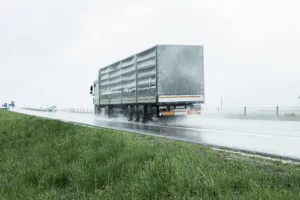Summer storms make driving difficult for truckers due to unpredictable weather and higher risks on the road. Seasonal storms like sudden downpours and high winds can make driving dangerous. Be careful of limited visibility, slippery roads, and the danger of tall vehicles, such as semi-trucks, tipping over. Hurricanes pose even greater risks during the summer months along coastal and certain inland routes.
For truck drivers, the safety stakes are high, making adherence to the Occupational Safety and Health Administration (OHSA) guidelines not just a regulatory requirement but a crucial component of daily operations. OSHA rules for severe weather are designed to protect drivers from the avoidable dangers posed by severe weather conditions.
Ensuring that vehicles are covered by robust commercial and semi-truck insurance policies is essential. Commercial truck insurance covers damages from storms. It also protects against losses caused by delays and cargo damage during severe weather disruptions.
Understanding and preparing for these risks with the right knowledge, safety strategies, and insurance coverage is key to navigating summer storms safely and effectively, ensuring that drivers not only comply with safety regulations but also protect their well-being and cargo integrity.

How Summer Storms Affect Truck Driving
Summer storms introduce specific challenges for truck drivers due to varied severe weather phenomena such as heavy rain, thunderstorms, and hurricanes. Each condition impacts driving dynamics differently, particularly for high-profile vehicles.
Impact of Heavy Rain:
- Reduced Visibility and Control: Heavy rain diminishes visibility and makes roads slick, increasing the likelihood of losing control, especially during braking.
- Risk of Hydroplaning: Accumulated water on highways can cause trucks to hydroplane, losing traction and potentially leading to severe accidents.
Challenges During Thunderstorms:
- High Winds and Vehicle Stability: Big trucks can be in danger when it’s very windy. The wind can push them off their path or even make them tip over because they are so large.
- Additional Hazards: Lightning and associated risks such as falling trees or power lines can create unexpected roadblocks, necessitating swift and cautious responses from drivers.
Hurricane Considerations:
- Extended Duration and Intensity: Hurricanes amplify the risks of thunderstorms and heavy rain, with added challenges like flooding and extensive road debris.
- Effects on Driving Dynamics:
- Braking Difficulties: Wet and slippery conditions require longer stopping distances and lower speeds.
- Navigational Obstacles: Constantly changing conditions and debris require dynamic decision-making to maintain safety.
Maintaining Visibility:
- Essential Equipment: Having working wipers, defoggers, and headlights is important for seeing clearly in heavy rain and storms.
Understanding and preparing for these dynamics through proper training, vehicle maintenance, and adherence to safety protocols is essential. These rules keep truck drivers and others safe when the weather is bad in the summer.
Insurance Preparedness: Commercial and Semi-Truck Coverage
During summer storms, having the appropriate commercial truck insurance is essential for truck drivers and fleet owners. It is not only required by regulations, but also plays a crucial role in managing financial risks. Commercial and semi-truck insurance policies provide essential protection against the unpredictable and often destructive nature of summer weather conditions.
Mitigating Financial Risks:
- Coverage for Damage: Commercial truck insurance typically covers damage from natural disasters like winds, hail, and floods. These events often happen during summer storms. This coverage helps mitigate the cost of repairs or replacement of the truck itself.
- Cargo Protection: During storms, the risk of cargo damage increases significantly. Many truck insurance plans include cargo insurance, which pays for damage or loss of cargo caused by weather accidents.
- Business Interruption: Some policies cover losses from business interruptions, compensating for lost income due to delays or cancellations caused by storms. Maintaining financial stability is vital when unexpected halts in operations occur.
Typical Insurance Coverage Details:
- Physical Damage: This basic coverage includes comprehensive protection against storm damage, such as from flying debris or falling objects, as well as collision coverage for accidents that occur due to slippery roads or poor visibility.
- Liability Insurance: Important for all vehicles. It pays for damage to other vehicles and medical expenses for injuries in accidents during storms.
- Additional Options: Some insurance companies offer additional services such as roadside assistance for trucks stuck in bad weather. They also provide insurance coverage for mechanical issues caused by storms.
For truck drivers navigating the challenges of summer storms, understanding the specifics of their insurance coverage is crucial. Having updated and thorough policies can give peace of mind and save money after weather events. Truckers should speak with their insurance providers about adjusting their coverage for possible problems that could arise in hot summer weather. This will safeguard their assets and ensure their business continues to operate without interruptions.

Essential Safety Tips for Summer Storm Driving
Driving a commercial truck during summer storms requires careful preparation and adherence to safety protocols. By following these essential tips, truck drivers can enhance their safety and reduce the risk of accidents when faced with heavy rain, high winds, and other severe weather conditions.
Pre-Trip Inspections and Vehicle Readiness:
- Thorough Vehicle Checks: Ensure that all parts of the truck, especially brakes, tires, windshield wipers, and lights, are in optimal condition. Check fluid levels, including windshield washer fluid, which is vital for maintaining visibility during heavy rains.
- Tire Inspection: Verify that tires are properly inflated and have sufficient tread depth to handle slick roads. Consider special tires if regularly driving in areas prone to severe storms.
Driving Strategies for Navigating Storms:
- Reduced Speed and Increased Following Distance: Lower your speed to adjust for reduced traction during rain. Increase the distance between your vehicle and others to allow more time for stopping.
- Avoiding Hydroplaning: If you start to hydroplane, ease off the accelerator and steer straight until you regain control. Avoid sudden turns or braking, which can exacerbate the situation.
- Handling High Winds: Be vigilant in high winds, especially when driving through open areas or over bridges. Reduce speed and hold the steering wheel firmly to prevent the truck from being blown off course.
- Navigating Floods: Avoid driving through flooded areas. It’s difficult to determine the depth of water. Even a small amount of water can lift a car and make steering difficult. If encountering water on the road, find an alternate route.
Post-Storm Procedures:
- Vehicle Inspection: After driving through severe weather, inspect your truck for any damage or issues that might have occurred during the storm. Pay special attention to the engine, tires, and electrical systems.
- Report Hazards: Inform relevant authorities about any road hazards encountered during your trip to help prevent accidents involving other drivers.
- Learn from Experience: Review how effectively you handled the situation and update your storm driving strategy accordingly. Feedback to your company might also help improve overall safety protocols.
By implementing these essential safety tips, truck drivers can significantly mitigate the risks associated with summer storm driving. Consistent training and regular updates on storm safety can help drivers improve their ability to safely navigate challenging conditions.
Preparing for the Unexpected: Safety Kits and Emergency Procedures
Effective preparation is key to ensuring safety when driving through summer storms. Truck drivers must equip themselves with comprehensive safety kits and have well-thought-out emergency procedures in place.
Essential Items for a Summer Storm Safety Kit:
- Weather Radio: A battery-powered or hand-crank weather radio to stay updated on storm developments.
- First Aid Kit: Includes bandages, antiseptics, pain relievers, and necessary medications.
- Flashlights and Extra Batteries: Crucial for power outages or nighttime emergencies.
- Non-perishable Food and Water: Enough to last at least 72 hours in case of stranding.
- Waterproof Clothing: Rain gear and waterproof boots to stay dry during outdoor checks or repairs.
- Road Flares and Warning Triangles: To alert other motorists in case of a roadside stop.
Tips for Handling Emergency Situations:
- Hurricane Preparedness: When a hurricane is forecasted, plan routes to avoid the affected areas. Monitor weather updates regularly and communicate with dispatchers about the safest times and routes for delivery.
- Sheltering Strategies: If caught in a hurricane or severe storm, seek shelter in a sturdy building. Avoid parking under overpasses or trees. If there is no shelter available, park the truck away from trees and other potential hazards and remain inside the vehicle.
- Emergency Communication: Keep a charged cell phone and a list of emergency contacts, including numbers for highway patrol and your company’s safety hotline. Use apps and GPS systems with real-time weather and traffic updates to stay informed.
- Evacuation Awareness: Know the evacuation routes in all areas where you drive. This information is crucial for escaping severe weather quickly and safely.
Truck drivers can handle summer storms better by having a safety kit and emergency plan. This helps keep them safe and protects their cargo and vehicle.
Technology and Tools for Weather Tracking
In the age of technology, staying ahead of the weather can mean the difference between a safe journey and a perilous one for truck drivers. Modern technology provides tools for predicting weather and planning routes, which are important during summer storms.
Importance of GPS and Weather Apps:
- Real-time Weather Updates: GPS systems integrated with weather tracking capabilities provide real-time updates and alerts on weather conditions. This technology helps drivers plan ahead and avoid dangerous conditions by changing routes before they encounter them.
- Route Optimization: Advanced GPS units can suggest alternate routes to avoid storm-affected areas, minimizing delays and enhancing safety. This feature is helpful during sudden weather changes such as flash floods or severe thunderstorms. During these events, regular routes may become unsafe or blocked.
Recommended Weather Tracking Apps:
- The Weather Channel: This app is well-known for being accurate and providing detailed weather information. It gives you real-time alerts, hourly forecasts, and a map showing weather patterns. This can help you decide whether to keep driving or stop for a break.
- AccuWeather: This app provides truck drivers with current rain forecasts and storm warnings. This helps them plan their routes more effectively by giving them accurate weather information.
- NOAA Weather Radar Live: This app gives detailed weather updates and radar images from the National Oceanic and Atmospheric Administration. It helps understand storm systems and plan for them.
Leveraging these technological tools enables truck drivers to navigate summer storms more safely and efficiently. By staying informed about weather conditions and using data to make informed decisions about routes and timing, drivers can significantly reduce the risks associated with severe weather challenges.
Importance of Preparation and Continued Education
Navigating summer storms safely requires thorough preparation, adequate commercial truck insurance coverage, and strict adherence to OSHA rules for severe weather. These measures are important for the safety of truck drivers, their cargo, and other road users.
Continuous education on summer storm safety can further enhance drivers’ ability to handle adverse weather conditions effectively. Staying informed and prepared ensures that every journey, regardless of the weather, is conducted as safely as possible.
Review Your Insurance and Enhance Your Safety Skills
Are you ready to weather any storm? Take a moment to request a free review of your current commercial or semi-truck insurance policies to ensure they provide comprehensive coverage for summer storms. Consider investing in additional training or resources to enhance your preparedness for adverse weather conditions. Stay safe and stay prepared!







